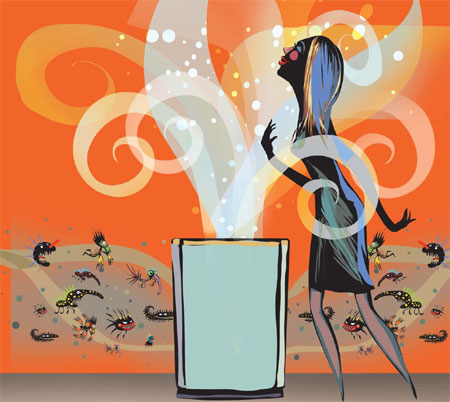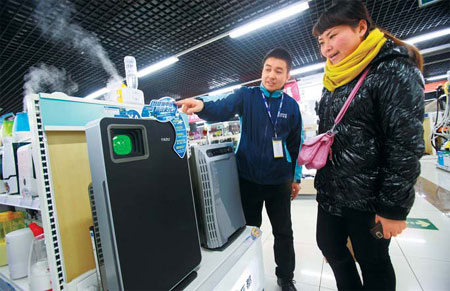Clearing the air
Updated: 2012-04-05 10:13
By Liu Zhihua (China Daily)
|
||||||||

|
|
|
A staff member introduces different varieties of air purifiers to a customer at a Suning Appliance store in Beijing on Dec 6. Heavy smog often chokes the capital, making air purifiers must-haves for many residents. Chen Xiaogen / for China Daily |
Air purifiers are becoming increasingly hot items, as concerns about pollution, especially PM 2.5, grows. Liu Zhihua reports.
Many people believed Wang Jingjing's parents were crazy when they spent 12,000 yuan ($1,905) on an air purifier in 2006. A doctor recommended the purifier, because Wang had severe allergic sinusitis. "Air purifiers were very rare then," the Shanghai Normal University student says. "My classmates would ask what the machine was when they visited my home. Nobody asks anymore." While they were once novelties, air purifiers are becoming must-haves for a growing number of urbanites. Major domestic brand Broad Group's sales grew by 300 percent from the second half of 2010 to the same period of 2011, Southern Weekend reports.
"Sales increases are in pace with growing awareness of air pollution," says professor Wu Jixiang, a clean air expert with Shanghai Jiao Tong University's Electricity Engineering Department.
"They're even more popular now than during SARS."
Wu says there are more than 300 air purifier manufacturers in the market - more than three times as many as when SARS terrified the country in 2003.
Beijing taxi driver Sun Jianhua bought an air purifier after this year's Spring Festival.
"Many of my friends and relatives use purifiers, because the pollution - especially automobile exhaust - is increasingly frightening," Sun says.
This year's winter and spring smog and sandstorms are conspicuously worse than previous years', Sun says.
China's economic growth has made air pollution a huge issue.
Experts say coal combustion pollution and photochemical pollution coexist and interact in China's air. PM 2.5, or particulate matter with a diameter of fewer than 2.5 microns, have become the primary pollutants.
Some PM 2.5 are emitted directly from coal combustion or construction sites. But most are created by complex reactions among chemicals, such as sulfur dioxides and nitrogen oxides, from power plants, industries and automobiles.
"PM 2.5 are invisible killers," says Wang Zhili, Beijing Chaoyang Diabetes Hospital director and National Committee of the Chinese People's Political Consultative Conference (CPPCC) member.
"You can't see them. But they can seriously harm your health."
While the number of smokers has dramatically decreased in recent years, lung cancer incidence has jumped to 61.4 per 100,000 people. That's 400,000 new diagnoses a year and a 46.8 percent increase over 30 years ago.
China is home to the world's largest lung cancer population. The disease accounts for 22 percent of cancer deaths.
"Air pollution, especially PM 2.5, must have played a role in lung cancer's rise to become the No 1 cancer killer," Wang says.
Beijing Hospital respiratory diseases expert Ke Huixing says studies have linked PM 2.5 exposure to a variety of illnesses, including asthma, lung cancer, stroke and birth defects.
PM 2.5 are only 1/30th the width of a hair. While larger particles can be filtered by the nose and expelled through the respiratory tract, PM 2.5 can become lodged deep in the lungs and produce acute and long-term effects, Ke explains.
Liquid in PM 2.5 irritates the respiratory tract, causing such acute problems as respiratory tract inflammations.
Lung nerve-fiber irritation can disrupt the nervous system's balance throughout the body, impairing normal cardiopulmonary function and blood flow.
And viruses and toxic substances attached to PM 2.5 get into the bloodstream and cause direct harm.
PM 2.5 are more hazardous to people with weaker organs, such as children and the elderly. And PM 2.5 exposure worsens cardiovascular diseases and diabetes, as their immunities have declined, Ke says.
"Whenever there's smog, we're busier the next day," the doctor says.
The public was ignorant of PM 2.5's hazards until recently.
Fearful discussions about the harm erupted online and spilled over to traditional media last October.
Yan Liang, a resident of Zhejiang province's capital Hangzhou, started using an air purifier last month in her office because she believes the air is unbearable.
She says many of her colleagues and friends have been using the devices, and some newlyweds even use air purifiers as lottery gifts to guests.
"They're helpful, whether you're worried about the formaldehyde in your newly decorated house or bad air outside," Yan says.
But resident Liao Haorong, who has used and recommended air purifiers for five years in Guangdong's provincial capital Guangzhou, says his friends don't take his advice.
"I always pay great attention to health and life quality," the former yoga coach and self-employed businessman says.
"I've been telling my friends that if they can spend several thousand yuan on an iPhone, why not invest in their health? But few listen. They say they don't want to waste money on something unnecessary, as they doubt air purifiers' effects."
CPPCC National Committee member Wang points out: "Air purifiers are only a temporary solution to air pollution and may cause secondary pollution if used improperly. Besides, people can't stay indoors all the time. The government should take measures to reduce PM 2.5."
Contact the writer at liuzhihua@chinadaily.com.cn.

 'Taken 2' grabs movie box office crown
'Taken 2' grabs movie box office crown
 Rihanna's 'Diamonds' tops UK pop chart
Rihanna's 'Diamonds' tops UK pop chart
 Fans get look at vintage Rolling Stones
Fans get look at vintage Rolling Stones
 Celebrities attend Power of Women event
Celebrities attend Power of Women event
 Ang Lee breaks 'every rule' to make unlikely new Life of Pi film
Ang Lee breaks 'every rule' to make unlikely new Life of Pi film
 Rihanna almost thrown out of nightclub
Rihanna almost thrown out of nightclub
 'Dark Knight' wins weekend box office
'Dark Knight' wins weekend box office
 'Total Recall' stars gather in Beverly Hills
'Total Recall' stars gather in Beverly Hills
Most Viewed
Editor's Picks

|

|

|

|

|

|
Today's Top News
Health new priority for quake zone
Xi meets US top military officer
Japan's boats driven out of Diaoyu
China mulls online shopping legislation
Bird flu death toll rises to 22
Putin appoints new ambassador to China
Japanese ships blocked from Diaoyu Islands
Inspired by Guan, more Chinese pick up golf
US Weekly

|

|







